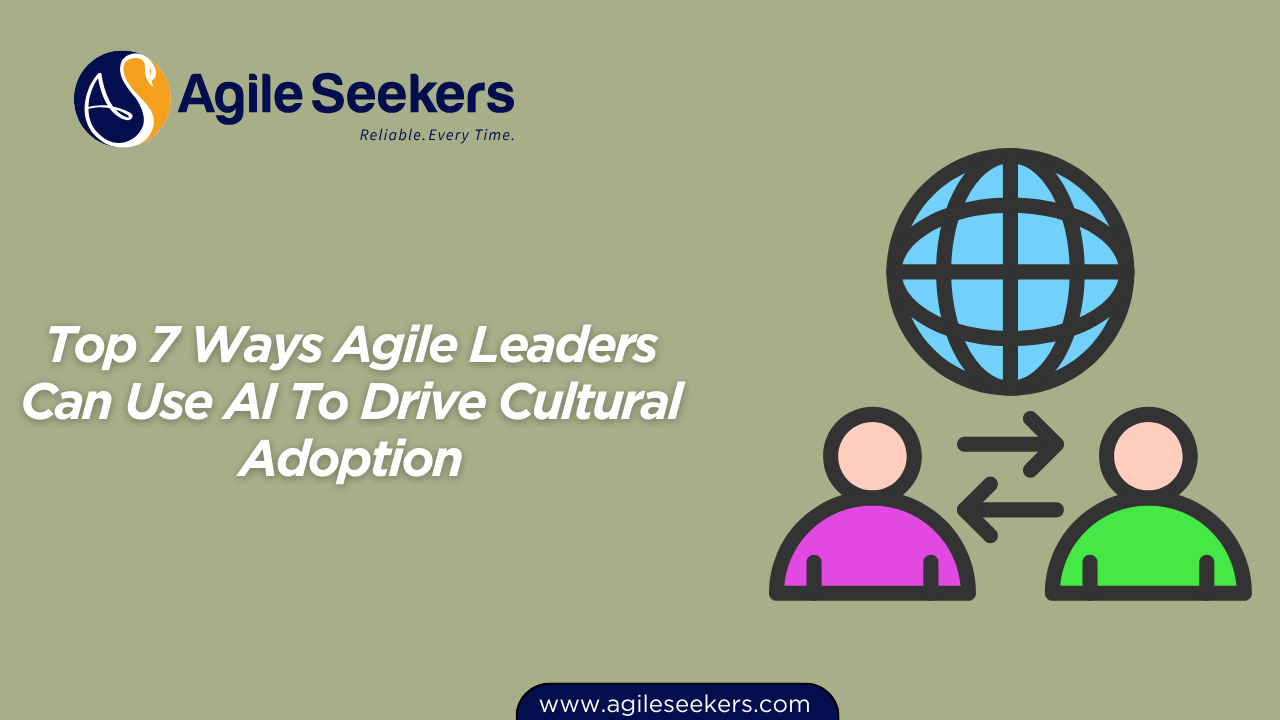Top 7 Ways Agile Leaders Can Use AI To Drive Cultural Adoption

Cultural adoption is the hardest part of any Agile transformation. Tools and frameworks can be rolled out quickly, but creating a mindset shift across teams takes time, persistence, and smart leadership. This is where Artificial Intelligence (AI) can become a true ally.
Agile leaders who understand how to use AI effectively can accelerate adoption, strengthen alignment, and foster a culture of continuous improvement.
Let’s break down seven powerful ways Agile leaders can use AI to drive cultural adoption.
1. Using AI to Measure Cultural Readiness
Before pushing change, leaders need to know where their organization stands. AI tools can analyze survey data, meeting transcripts, and communication patterns to detect levels of engagement, collaboration, and resistance. Instead of relying on gut feeling, Agile leaders gain a data-driven view of cultural readiness.
For example, sentiment analysis can reveal whether teams perceive Agile practices as empowering or burdensome. With that insight, leaders can adjust their approach and provide tailored support.
👉 If you’re preparing to lead this type of change, the AI for Agile Leaders & Change Agents Certification is a strong starting point.
2. Identifying Change Champions with AI Insights
Cultural adoption succeeds faster when influential voices within the organization support it. AI can analyze communication networks and performance data to identify hidden influencers—people who may not hold formal leadership roles but have the trust of their peers.
By empowering these individuals as change champions, leaders create grassroots momentum for Agile adoption. This moves the culture shift from being “management-driven” to team-owned.
3. AI-Powered Feedback Loops for Continuous Improvement
One hallmark of Agile culture is embracing feedback. AI enhances this by turning large volumes of feedback into actionable insights. For example, AI can process retrospective notes, employee surveys, or even chat data to surface recurring themes.
Instead of leaders manually sifting through inputs, AI highlights patterns—like recurring frustrations with dependencies or recognition of strong team collaboration. These insights allow leaders to address issues proactively and celebrate cultural wins.
To deepen this practice, leaders can draw on the structured frameworks from the Leading SAFe Agilist Certification, which emphasizes aligning culture with value delivery.
4. Embedding AI into Training and Learning
Cultural adoption improves when training feels relevant and personal. AI-driven learning platforms can adapt content to different roles and experience levels. For example, a Scrum Master might receive coaching simulations around facilitation, while a Product Owner could explore backlog refinement with AI-guided prompts.
This personalization keeps teams engaged and accelerates skill-building, making Agile practices second nature.
Scrum Masters looking to leverage AI in their role can explore the AI for Scrum Masters Training.
5. Enhancing Transparency Through AI Dashboards
One cultural barrier Agile leaders often face is lack of transparency. Teams may resist Agile adoption if they can’t clearly see progress or value delivery. AI-powered dashboards solve this by making metrics more meaningful.
Instead of raw velocity charts, AI can show predictive insights—like whether the current sprint plan risks burnout or if dependencies could cause delivery delays. This transparency helps teams trust the process and reinforces accountability.
Project leaders interested in strengthening transparency practices can benefit from the PMP Certification Training, which integrates both traditional and Agile project approaches.
6. Using AI to Coach Leaders and Teams
Cultural adoption often stalls because leaders themselves struggle with new behaviors. AI-powered coaching assistants can provide leaders with nudges, conversation prompts, and feedback on their interactions. For instance, if a leader dominates discussions, AI can suggest ways to ask more open-ended questions.
This type of just-in-time coaching fosters humility, empathy, and servant leadership—values that are central to Agile culture.
For team-facing roles, programs like the SAFe Scrum Master Certification and the SAFe Advanced Scrum Master Certification Training build a strong foundation that can be further enhanced with AI tools.
7. Aligning Strategy to Execution with AI
One of the toughest cultural hurdles is closing the gap between leadership strategy and team-level execution. AI can map organizational goals against backlog items, identifying misalignments or wasted effort.
For example, if a strategic goal focuses on customer satisfaction but backlog items mainly address internal tooling, AI can highlight the disconnect. Leaders can then reframe priorities and help teams see how their work ties to outcomes.
Product leaders exploring this alignment should look at the SAFe POPM Certification, and for AI’s role in product ownership, the AI for Product Owners Certification Training.
Why AI and Culture Go Hand-in-Hand
AI doesn’t replace the human side of leadership—it amplifies it. Cultural adoption is about trust, mindset, and shared ownership. What AI brings is clarity, personalization, and faster feedback loops. Agile leaders who combine human empathy with AI-powered insights are better equipped to nurture environments where Agile values stick.
For project managers navigating both strategy and execution, the AI for Project Managers Certification Training offers practical guidance.
To further explore AI’s role in leadership and cultural change, check out external resources like MIT Sloan’s AI and Organizational Culture research, which provides deeper perspectives on AI-driven culture building.
Final Thoughts
Driving cultural adoption is not a one-time effort—it’s a continuous journey. Agile leaders must balance vision with adaptability, and AI is proving to be one of the most powerful tools in that journey. From measuring readiness to aligning strategy, AI helps leaders remove friction and accelerate cultural embedding.
The leaders who embrace AI today aren’t just improving adoption rates; they’re building organizations where agility becomes part of the DNA.
Also read - Why Every Agile Professional Needs AI Literacy For Career Growth
Also see - How AI Helps Change Agents Align Vision To Execution




















